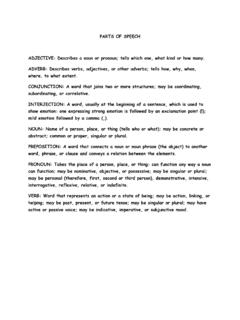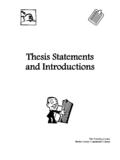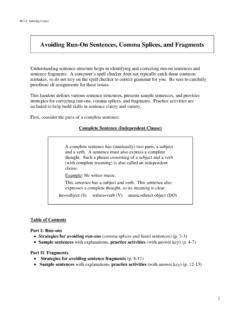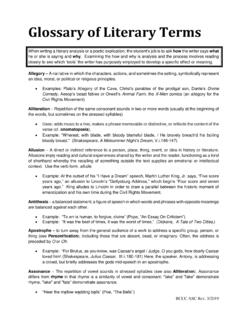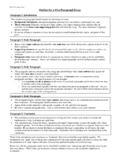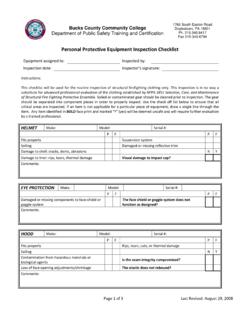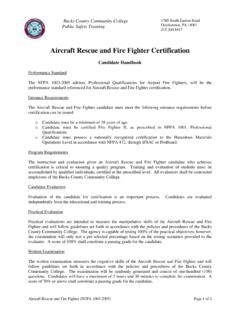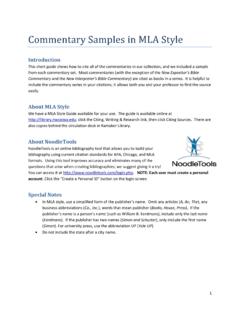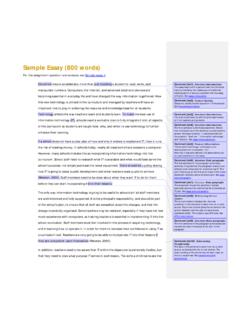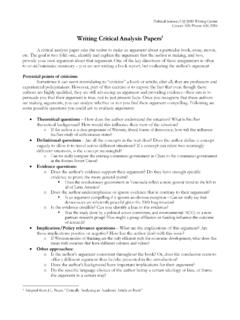Transcription of HOW TO WRITE A LITERARY ANALYSIS ESSAY
1 HOW TO WRITE A LITERARY ANALYSIS ESSAY The purpose of a LITERARY ANALYSIS ESSAY is to carefully examine and sometimes evaluate a work of literature or an aspect of a work of literature. As with any ANALYSIS , this requires you to break the subject down into its component parts. Examining the different elements of a piece of literature is not an end in itself but rather a process to help you better appreciate and understand the work of literature as a whole. For instance, an ANALYSIS of a poem might deal with the different types of images in a poem or with the relationship between the form and content of the work.
2 If you were to analyze (discuss and explain) a play, you might analyze the relationship between a subplot and the main plot, or you might analyze the character flaw of the tragic hero by tracing how it is revealed through the acts of the play. Analyzing a short story might include identifying a particular theme (like the difficulty of making the transition from adolescence to adulthood) and showing how the writer suggests that theme through the point of view from which the story is told; or you might also explain how the main character s attitude toward women is revealed through his dialogue and/or actions.
3 REMEMBER: Writing is the sharpened, focused expression of thought and study. As you develop your writing skills, you will also improve your perceptions and increase your critical abilities. Writing ultimately boils down to the development of an idea. Your objective in writing a LITERARY ANALYSIS ESSAY is to convince the person reading your ESSAY that you have supported the idea you are developing. Unlike ordinary conversation and classroom discussion, writing must stick with great determination to the specific point of development.
4 This kind of writing demands tight organization and control. Therefore, your ESSAY must have a central idea (thesis), it must have several paragraphs that grow systematically out of the central idea, and everything in it must be directly related to the central idea and must contribute to the reader s understanding of that central idea. These three principles are listed again below: 1. Your ESSAY must cover the topic you are writing about. 2. Your ESSAY must have a central idea (stated in your thesis) that governs its development.
5 3. Your ESSAY must be organized so that every part contributes something to the reader s understanding of the central idea. THE ELEMENTS OF A SOLID ESSAY The Thesis Statement The thesis statement tells your reader what to expect: it is a restricted, precisely worded declarative sentence that states the purpose of your ESSAY -- the point you are trying to make. Without a carefully conceived thesis, an ESSAY has no chance of success. The following are thesis statements which would work for a 500-750 word LITERARY ANALYSIS ESSAY : Gwendolyn Brooks s 1960 poem The Ballad of Rudolph Reed demonstrates how the poet uses the conventional poetic form of the ballad to treat the unconventional poetic subject of racial intolerance.
6 The fate of the main characters in Antigone illustrates the danger of excessive pride. The imagery in Dylan Thomas s poem Fern Hill reveals the ambiguity of humans relationship with nature. Typically, the thesis statement falls at the end of your introductory paragraph. 2 The Introduction The introduction to your LITERARY ANALYSIS ESSAY should try to capture your reader s interest. To bring immediate focus to your subject, you may want to use a quotation, a provocative question, a brief anecdote, a startling statement, or a combination of these.
7 You may also want to include background information relevant to your thesis and necessary for the reader to understand the position you are taking. In addition, you need to include the title of the work of literature and name of the author. The following are satisfactory introductory paragraphs which include appropriate thesis statements: A. What would one expect to be the personality of a man who has his wife sent away to a convent (or perhaps has had her murdered) because she took too much pleasure in the sunset and in a compliment paid to her by another man?
8 It is just such a man a Renaissance duke who Robert Browning portrays in his poem My Last Duchess. A character ANALYSIS of the Duke reveals that through his internal dialogue, his interpretation of earlier incidents, and his actions, his traits arrogance, jealousy, and greediness emerge. B. The first paragraph of Alberto Alvaro Rios s short story The Secret Lion presents a twelve-year-old boy s view of growing up everything changes. As the narrator informs the reader, when the magician pulls a tablecloth out from under a pile of dishes, children are amazed at the stay-the-same part, while adults focus only on the tablecloth itself (42).
9 Adults have the benefit of experience and know the trick will work as long as the technique is correct. When people grow up, they gain this experience and knowledge but lose their innocence and sense of wonder. In other words, the price paid for growing up is a permanent sense of loss. This tradeoff is central to The Secret Lion. The key symbols in the story reinforce its main theme: change is inevitable and always accompanied by a sense of loss. C. The setting of John Updike s story A & P is crucial to the reader s understanding of Sammy s decision to quit his job.
10 Even though Sammy knows that his quitting will make life more difficult for him, he instinctively insists upon rejecting what the A & P represents in the story. When he rings up a No Sale and saunter[s] out of the store, Sammy leaves behind not only a job but the rigid state of mind associated with the A & P. Although Sammy is the central character in the story, Updike seems to invest as much effort in describing the setting as he does Sammy. The title, after all, is not Youthful Rebellion or Sammy Quits but A & P.
